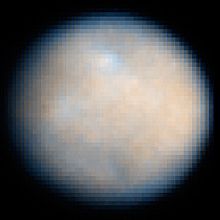- Dwarf planet
-
Not to be confused with Minor planet.
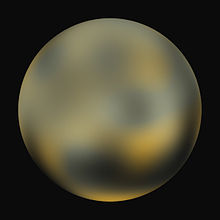 Pluto in approximate true colour based on Hubble Space Telescope albedo data
Pluto in approximate true colour based on Hubble Space Telescope albedo data
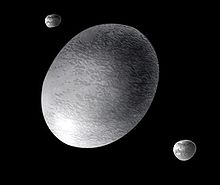 Haumea with its moons, Hiʻiaka and Namaka (artist's conception)
Haumea with its moons, Hiʻiaka and Namaka (artist's conception)
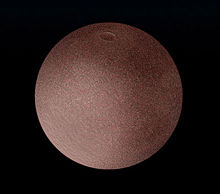 Makemake (artist's conception)
Makemake (artist's conception)
 Eris as seen with the Hubble Space Telescope
Eris as seen with the Hubble Space Telescope
A dwarf planet, as defined by the International Astronomical Union (IAU), is a celestial body orbiting the Sun[1] that is massive enough to be spherical as a result of its own gravity but has not cleared its neighboring region of planetesimals and is not a satellite.[2][3] More explicitly, it has to have sufficient mass to overcome its compressive strength and achieve hydrostatic equilibrium.
The term dwarf planet was adopted in 2006 as part of a three-way categorization of bodies orbiting the Sun,[1] brought about by an increase in discoveries of trans-Neptunian objects that rivaled Pluto in size, and finally precipitated by the discovery of an even more massive object, Eris.[4] This classification states that bodies large enough to have cleared the neighbourhood of their orbit are defined as planets, while those that are not massive enough to be rounded by their own gravity are defined as small Solar System bodies. Dwarf planets come in between. The definition officially adopted by the IAU in 2006 has been both praised and criticized, and has been disputed by scientists such as Alan Stern.[5][6]
The IAU currently recognizes five dwarf planets in the Solar System: Ceres, Pluto, Haumea, Makemake, and Eris.[7] However, only two of these bodies, Ceres and Pluto, have been observed in enough detail to demonstrate that they fit the definition. Eris has been accepted as a dwarf planet because it is more massive than Pluto. The IAU subsequently decided that unnamed trans-Neptunian objects with an absolute magnitude brighter than +1 (and hence a mathematically delimited minimum diameter of 838 km)[8] are to be named under the assumption that they are dwarf planets. The only two such objects known at the time, Makemake and Haumea, went through this naming procedure and were declared to be dwarf planets.
It is suspected that at least another fifty known objects in the Solar System are dwarf planets, and estimates are that up to 200 dwarf planets may be found when the entire region known as the Kuiper belt is explored, and that the number might be as high as 2,000 when objects scattered outside the Kuiper belt are considered.[9] Astronomer Mike Brown, who discovered three of the five IAU-recognized dwarf planets, published in August 2011 his own list of 390 candidate objects, organized in categories from "nearly certainly" to "possibly" meeting the IAU's criteria, along with his classification methodology.[10] Brown identifies nine known objects – the five mentioned plus 2007 OR10, Sedna, Quaoar, and Orcus – as "virtually certain",[11] with another two dozen highly likely,[11] and there are probably a hundred or so such objects in total.[11]
The classification of bodies in other planetary systems with the characteristics of dwarf planets has not been addressed,[12] although if they were detectable they would not be considered planets.[13]
Contents
History of the concept
Main article: IAU definition of planetBefore the discoveries of the early 21st century, astronomers had no strong need for a formal definition of a planet. With the discovery of Pluto in 1930, astronomers considered the Solar System to have nine planets, along with thousands of significantly smaller bodies such as asteroids and comets. For almost 50 years Pluto was thought to be larger than Mercury,[14][15] but with the discovery in 1978 of Pluto's moon Charon, it became possible to measure Pluto's mass accurately and determine that it is much smaller than the initial estimates.[16] It was roughly one-twentieth the mass of Mercury, which made Pluto by far the smallest planet. Although it was still more than ten times as massive as the largest object in the asteroid belt, Ceres, it was one-fifth that of Earth's Moon.[17] Furthermore, having some unusual characteristics such as large orbital eccentricity and a high orbital inclination, it became evident it was a completely different kind of body from any of the other planets.[18]
In the 1990s, astronomers began to find objects in the same region of space as Pluto (now known as the Kuiper belt), and some even farther away.[19] Many of these shared some of the key orbital characteristics of Pluto, and Pluto started being seen as the largest member of a new class of objects, plutinos. This led some astronomers to stop referring to Pluto as a planet. Several terms including minor planet, subplanet, and planetoid started to be used for the bodies now known as dwarf planets.[20][21] By 2005, three other bodies comparable to Pluto in terms of size and orbit (Quaoar, Sedna, and Eris) had been reported in the scientific literature.[22] It became clear that either they would also have to be classified as planets, or Pluto would have to be reclassified.[23] Astronomers were also confident that more objects as large as Pluto would be discovered, and the number of planets would start growing quickly if Pluto were to remain a planet.[24]
In 2006, Eris (then known as 2003 UB313) was believed to be slightly larger than Pluto, and some reports unofficially referred to it as the tenth planet.[25] As a consequence, the issue became a matter of intense debate during the IAU General Assembly in August 2006.[26] The IAU's initial draft proposal included Charon, Eris, and Ceres in the list of planets. After many astronomers objected to this proposal, an alternative was drawn up by Uruguayan astronomer Julio Ángel Fernández, in which he created a median classification for objects large enough to be round but that had not cleared their orbits of planetesimals. Dropping Charon from the list, the new proposal also removed Pluto, Ceres, and Eris, since they have not cleared their orbits.[27]
The IAU's final resolution preserved this three-category system for the celestial bodies orbiting the Sun. Fernández suggested calling these median objects planetoids,[28][29] but the IAU's division III plenary session voted unanimously to call them dwarf planets.[1] The resolution, #5A, reads:
The IAU ... resolves that planets and other bodies, except satellites, in our Solar System be defined into three distinct categories in the following way:
(1) A planet1 is a celestial body that (a) is in orbit around the Sun, (b) has sufficient mass for its self-gravity to overcome rigid body forces so that it assumes a hydrostatic equilibrium (nearly round) shape, and (c) has cleared the neighbourhood around its orbit.
(2) A “dwarf planet” is a celestial body that (a) is in orbit around the Sun, (b) has sufficient mass for its self-gravity to overcome rigid body forces so that it assumes a hydrostatic equilibrium (nearly round) shape,2 (c) has not cleared the neighbourhood around its orbit, and (d) is not a satellite.
(3) All other objects,3 except satellites, orbiting the Sun shall be referred to collectively as “Small Solar System Bodies.”- Footnotes:
- 1 The eight planets are: Mercury, Venus, Earth, Mars, Jupiter, Saturn, Uranus, and Neptune.
- 2 An IAU process will be established to assign borderline objects either dwarf planet or other status.
- 3 These currently include most of the Solar System asteroids, most Trans-Neptunian Objects (TNOs), comets, and other small bodies.
The term dwarf planet has itself been somewhat controversial, as a grammatical reading suggests these bodies are planets. The IAU's Resolution 5A was accompanied by a second resolution, 5B, which defined dwarf planets as a subtype of planet, distinguished from the other eight which were to be called "classical planets". Under this arrangement, the twelve planets of the rejected proposal were to be preserved in a distinction between eight "classical planets" and four "dwarf planets". However, resolution 5B was defeated in the same session that 5A was passed, so that only the dwarf planet half of the proposal was made official.[30] Because of the confusion caused by the term dwarf planet being defined as a non-planet, alternative proposals such as nanoplanet and subplanet were suggested.[31] However, while IAU committee members argued that the term dwarf planet logically refers to a subtype of planet, just as a dwarf star is a type of star, it's analogous to a minor planet, which also does not qualify as a planet, and which was coined as a dichotomy between minor and major planets.
In most languages equivalent terms have been created by translating dwarf planet more-or-less literally: French planète naine, German Zwergplanet, Russian карликовая планета karlikovaya planeta, Arabic كوكب قزم kaukab qazm, Chinese 矮行星 ǎixíngxīng, etc., but Japanese is an exception: In Japanese these bodies are called junwakusei 準惑星, where wakusei 惑星 is 'planet' and jun- 準 is a prefix corresponding to English quasi-, pene- (almost), and sub-. Thus in Japanese they are called 'subplanets' or 'almost-planets'.
Although concerns were raised about the classification of planets orbiting other stars,[12] the issue was not resolved; it was proposed instead to decide this only when such objects start being observed.[27]
The 2006 IAU's Resolution 6a[32] recognizes Pluto as "the prototype of a new category of trans-Neptunian objects". The name and precise nature of this category were not specified but left for the IAU to establish at a later date; in the debate leading up to the resolution, the members of the category were variously referred to as plutons and plutonian objects but neither name was carried forward.[1] On June 11, 2008, the IAU Executive Committee announced a name, plutoid, and a definition: all trans-Neptunian dwarf planets are plutoids.[33] On July 18, 2008, the Working Group for Planetary System Nomenclature classified the object then known as (136472) 2005 FY9 as a dwarf planet, and named it Makemake.[34]
Characteristics
Planetary discriminants[35] Body Mass (ME*) Λ** µ*** Mercury 0.055 1.95 × 103 9.1 × 104 Venus 0.815 1.66 × 105 1.35 × 106 Earth 1 1.53 × 105 1.7 × 106 Mars 0.107 9.42 × 102 1.8 × 105 Ceres 0.000 15 8.32 × 10−4 0.33 Jupiter 317.7 1.30 × 109 6.25 × 105 Saturn 95.2 4.68 × 107 1.9 × 105 Uranus 14.5 3.85 × 105 2.9 × 104 Neptune 17.1 2.73 × 105 2.4 × 104 Pluto 0.002 2 2.95 × 10−3 0.077 Haumea 0.000 67 2.68 × 10–4 0.02 Makemake 0.000 67 2.22 × 10–4 0.02[36] Eris 0.002 8 2.13 × 10−3 0.10 *ME in Earth masses.
**Λ = k M2 a-3/2, where k = 0.0043 for units of Yg and AU. Λ > 1 for planets.[37]
**µ = M/m, where M is the mass of the body,
and m is the aggregate mass of all the other bodies
that share its orbital zone. µ > 100 for planets.Orbital dominance
Main article: Clearing the neighbourhoodAlan Stern and Harold F. Levison introduced a parameter Λ (lambda), expressing the likelihood of an encounter resulting in a given deflection of orbit.[37] The value of this parameter in Stern's model is proportional to the square of the mass and inversely proportional to the period. Following the authors, this value can be used to estimate the capacity of a body to clear the neighbourhood of its orbit, where Λ > 1 will eventually clear it. A gap of five orders of magnitude in Λ was found between the smallest terrestrial planets and the largest asteroids and Kuiper belt objects.[35]
Using this parameter, Steven Soter and other astronomers argued for a distinction between planets and dwarf planets based on the inability of the latter to "clear the neighbourhood around their orbits": planets are able to remove smaller bodies near their orbits by collision, capture, or gravitational disturbance, (or establish orbital resonances that prevent collisions), while dwarf planets lack the mass to do so.[37] Soter went on to propose a parameter he called the planetary discriminant, designated with the symbol µ (mu), that represents an experimental measure of the actual degree of cleanliness of the orbital zone (where µ is calculated by dividing the mass of the candidate body by the total mass of the other objects that share its orbital zone), where µ > 100 is deemed to be cleared.[35] There are several other schemes that try to differentiate between planets and dwarf planets,[5] but the 2006 definition uses this concept.[1]
Size and mass
Main article: Hydrostatic equilibriumSufficient internal pressure, caused by the body's gravitation, will turn a body plastic, and sufficient plasticity will allow high elevations to sink and hollows to fill in, a process known as gravitational relaxation. Bodies smaller than a few kilometers are dominated by non-gravitational forces and tend to be angular in shape. Larger objects, where gravitation is significant but not dominant, are "potato" shaped; the more massive the body is, the higher its internal pressure and the more rounded its shape, until it achieves maximum rounding at hydrostatic equilibrium. This is the defining limit of a dwarf planet.[38]
When an object is in hydrostatic equilibrium, a global layer of liquid covering its surface would form a liquid surface of the same shape as the body, apart from small-scale surface features such as craters and fissures. If the body does not rotate, it will be a sphere, but the faster it does rotate, the more oblate or even scalene it becomes. However, if such a rotating body were to be heated until it melted, its overall shape would not change when liquid. The extreme example of a non-spherical body in hydrostatic equilibrium is Haumea, which is twice as long along its major axis as it is at the poles.
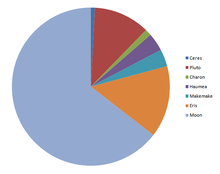 The masses of the four largest plutoids, plus Ceres and Charon, relative to the Earth's Moon. The mass of Makemake is a rough estimate. (See plutoid for a graph of several additional dwarf planets without Ceres.)
The masses of the four largest plutoids, plus Ceres and Charon, relative to the Earth's Moon. The mass of Makemake is a rough estimate. (See plutoid for a graph of several additional dwarf planets without Ceres.)
The upper and lower size and mass limits of dwarf planets have not been specified by the IAU. There is no defined upper limit, and an object larger or more massive than Mercury that has not "cleared the neighbourhood around its orbit" would be classified as a dwarf planet.[39] The lower limit is determined by the requirements of achieving a hydrostatic equilibrium shape, but the size or mass at which an object attains this shape depends on its composition and thermal history. The original draft of the 2006 IAU resolution redefined hydrostatic equilibrium shape as applying "to objects with mass above 5×1020 kg and diameter greater than 800 km",[12] but this was not retained in the final draft.[1]
Empirical observations suggest that the lower limit will vary according to the composition and thermal history of the object. For a body made of rigid silicates, such as the stony asteroids, the transition to hydrostatic equilibrium should occur at a diameter of approximately 600 km and a mass of some 3.4×1020 kg. For a body made of less rigid water ice, the limit should be about 320 km and ×1019 kg.[40] In the asteroid belt, Ceres is the only body that clearly surpasses the silicaceous limit (though it is actually a rocky–icy body), and its shape is an equilibrium spheroid. 2 Pallas and 4 Vesta, however, are rocky and are just below the limit. Pallas, at 525–560 km and 1.85–2.4×1020 kg, is "nearly round" but still somewhat irregular. Vesta, at 530 km and 2.6×1020 kg, deviates from an ellipsoid shape primarily due to a large impact basin at its pole, but even so its equatorial diameters are not equal as they would be under equilibrium, and as they are for Ceres.
Among icy bodies, the smallest known to be in hydrostatic equilibrium is Mimas, at 396 km and 3.75×1019 kg. The largest irregular body in the outer Solar System is Proteus, nearly-but-not-quite round at 405–435 km and an assumed mass of ≈4.4×1019 kg. Mimas appears to have had a warmer thermal history than Proteus.[citation needed] Neither body is pure ice as used to calculate the lowest limit, however, and Mike Brown suggests that the practical lower limit for an icy dwarf planet is likely to be somewhere under 400 km.[9] There are about 100 TNOs currently estimated to be above this size.
Official and "nearly certain" dwarf planets
As of 2011, there are five objects officially classified as dwarf planets,[41] with four others thought to be "nearly certain".[11] For two of these, Ceres and Pluto, this is known through direct observation. The other seven are thought to be dwarf planets from mathematical modeling: they are large enough or massive enough to be in hydrostatic equilibrium even if they are primarily rocky and at the lower end of their estimated values. Eris is more massive than Pluto; Haumea and Makemake were accepted as dwarf planets for the purposes of naming by the IAU, whose naming rules are based on absolute magnitude.[7][32] In relative distance from the Sun, the five are:
- Ceres
 – discovered on January 1, 1801, 45 years before Neptune. Considered a planet for half a century before reclassification as an asteroid. Accepted as a dwarf planet by the IAU on September 13, 2006.
– discovered on January 1, 1801, 45 years before Neptune. Considered a planet for half a century before reclassification as an asteroid. Accepted as a dwarf planet by the IAU on September 13, 2006. - Pluto
 – discovered on February 18, 1930. Classified as a planet for 76 years. Reclassified as a dwarf planet by the IAU on August 24, 2006.
– discovered on February 18, 1930. Classified as a planet for 76 years. Reclassified as a dwarf planet by the IAU on August 24, 2006. - Haumea – discovered on December 28, 2004. Accepted by the IAU as a dwarf planet on September 17, 2008.
- Makemake – discovered on March 31, 2005. Accepted by the IAU as a dwarf planet on July 11, 2008.
- Eris – discovered on January 5, 2005. Called the "tenth planet" in media reports. Accepted by the IAU as a dwarf planet on September 13, 2006.
Brown's list identifies four other objects as "nearly certainly" being dwarf planets:
- Orcus – discovered on February 17, 2004.
- Quaoar – discovered on June 5, 2002.
- 2007 OR10 – discovered on July 17, 2007.
- Sedna – discovered on November 14, 2003.
No space probes have visited any of these. This will change if NASA's Dawn and New Horizons missions reach Ceres and Pluto, respectively, as planned in 2015.[42][43] Dawn entered orbit around potential dwarf planet Vesta, on July 16, 2011.[44]
Orbital attributes of dwarf planets[45] Name Region of
Solar SystemOrbital
radius (AU)Orbital period
(years)Mean orbital
speed (km/s)Inclination
to eclipticOrbital
eccentricityPlanetary
discriminantCeres Asteroid belt 2.77 4.60 17.882 10.59° 0.079 0.33 Pluto Kuiper belt (plutino) 39.48 248.09 4.666 17.14° 0.249 0.077 Haumea Kuiper belt (12:7) 43.13 283.28 28.22° 0.195 0.020 Makemake Kuiper belt (cubewano) 45.79 309.9 4.419 28.96° 0.159 0.02 Eris Scattered disc 67.67 557 3.436 44.19° 0.442 0.10 Physical attributes of dwarf planets Name Equatorial
diameter
relative to
the MoonEquatorial
diameter
(km)[11]Mass
relative to
the MoonMass
(×1021 kg)Density
(g/cm3)Surface
gravity
(m/s2)Escape
velocity
(km/s)Axial
inclinationRotation
period
(days)Moons Surface
temp.
(K)Atmosphere Ceres 28% 974.6±3.2 1.3% 0.94 2.08 0.27 0.51 ≈ 3° 0.38 0 167 none Pluto 66% 2306±10 17.8% 13.05 2.0 0.58 1.2 119.59° −6.39 4 44 transient Haumea ≈ 43% 1500±? 5.5% 4.01 ± 0.04 2.6–3.3 (?) 0.16 2 32 ± 3 ? Makemake ≈ 41% 1440±? ≈ 4% ? ≈ 3 ? ? ? 0.32 0 ≈ 30 transient? Eris ≈ 67% 2330±? 22.7% 16.7 2.5 ≈ 0.8 1.3 ≈ 1 (0.75–1.4) 1 ≈ 42 transient? Orbital attributes of "nearly certain" dwarf planets[45] Name Region of
Solar SystemOrbital
radius (AU)Orbital period
(years)Mean orbital
speed (km/s)Inclination
to eclipticOrbital
eccentricityPlanetary
discriminantOrcus Kuiper belt (plutino) 39.17 245.18 20.57° 0.227 0.003 Quaoar Kuiper belt (cubewano) 43.405 285.97 8.00° 0.039 0.007–0.010 2007 OR10 Scattered disc (10:3?) 67.21 550.98 30.70° 0.500 ? Sedna Detached 518.57 ~11,400 11.93° 0.853 ? Physical attributes of "nearly certain" dwarf planets Name Equatorial
diameter
relative to
the MoonEquatorial
diameter
(km)[11]Mass
relative to
the MoonMass
(×1021 kg)Density
(g/cm3)Surface
gravity
(m/s2)Escape
velocity
(km/s)Axial
inclinationRotation
period
(days)Moons Surface
temp.
(K)Atmosphere Orcus ≈ 27% 950±? 0.9% 0.63 ° 0.55 1 Quaoar ≈ 28% 980±? 1.8–2.6% 1.6 ± 0.3 ° 0.74 1 2007 OR10 ≈ 41% 1420±? ? ? ? 0 Sedna ≈ 40% 1400±? 2.4–5.9% 1.8–4.3 ? 0.42 0 ≈ 12 Additional candidates
Main article: List of dwarf-planet candidates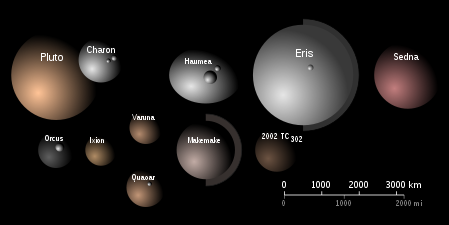 Illustration of the relative sizes, albedos, and colours of the largest trans-Neptunian objects
Illustration of the relative sizes, albedos, and colours of the largest trans-Neptunian objects
After Ceres, the next-most-massive body in the asteroid belt, Vesta, might also be classified as a dwarf planet, as its shape appears to deviate from hydrostatic equilibrium largely because of a large impact that occurred after it solidified.[46] The definition of dwarf planet does not specifically address this issue. The Dawn probe orbiting Vesta since July 2011 may help clarify matters.[42]
Many trans-Neptunian objects (TNOs) are thought to have icy cores and therefore would require a diameter of perhaps 400 km (250 mi)—only about 3% of that of Earth—to relax into gravitational equilibrium, making them dwarf planets of the plutoid class.[9] Although only rough estimates of the diameters of these objects are available, as of 2011 it was believed that a hundred of the known bodies beyond Neptune were probable dwarf planets.[11] A team is investigating thirty of these, and believe that the number will eventually prove to be about 200 in the Kuiper belt and many more beyond.[9]
Ellipsoidal moons
See also: List of moons by diameterNineteen moons are known to be massive enough to have relaxed into a rounded shape under their own gravity. These bodies have no significant physical differences from the dwarf planets, but are not considered members of that class because they do not directly orbit the Sun. They are Earth's moon, the four Galilean moons of Jupiter (Io, Europa, Ganymede, and Callisto), seven moons of Saturn (Mimas, Enceladus, Tethys, Dione, Rhea, Titan, and Iapetus), five moons of Uranus (Miranda, Ariel, Umbriel, Titania, and Oberon), one moon of Neptune (Triton), and one moon of Pluto (Charon).
The status of Charon is unclear, as there is currently no definition of what distinguishes a satellite system from a binary (double planet) system. The original draft resolution (5)[12] presented to the IAU stated Charon could be considered a planet because:
- Charon independently would satisfy the size and shape criteria for a dwarf planet status (in the terms of the final resolution);
- Charon revolves with Pluto around a common center of mass located between the two bodies (rather than within one of the bodies) because Charon's mass is not insignificant relative to that of Pluto.[47] Note, however, that the Jupiter–Sun centre of mass also lies outside the Sun, and so such a definition would imply that Jupiter is not a satellite of the Sun and therefore not a planet.
This definition was not preserved in the IAU's final resolution, which did not mention the status of Charon.
Contention
In the immediate aftermath of the IAU definition of dwarf planet, a number of scientists expressed their disagreement with the IAU resolution.[5] Campaigns included car bumper stickers and T-shirts.[48] Mike Brown (the discoverer of Eris) agrees with the reduction of the number of planets to eight.[49]
NASA has announced that it will use the new guidelines established by the IAU.[50] However, Alan Stern, the director of NASA's mission to Pluto, rejects the current IAU definition of planet, both in terms of defining dwarf planets as something other than a type of planet, and in using orbital characteristics (rather than intrinsic characteristics) of objects to define them as dwarf planets.[51] Thus, as of January 2008, he and his team still referred to Pluto as the ninth planet,[52] while accepting the characterization of dwarf planet for Ceres and Eris.
See also
- List of planetary bodies
- Lists of small Solar System bodies
- List of Solar System bodies formerly regarded as planets
- List of Solar System objects in hydrostatic equilibrium
- Mesoplanet
References
- ^ a b c d e f "Definition of a Planet in the Solar System: Resolutions 5 and 6" (PDF). IAU 2006 General Assembly (International Astronomical Union). 2006-08-24. http://www.iau.org/static/resolutions/Resolution_GA26-5-6.pdf. Retrieved 2008-01-26.
- ^ "IAU 2006 General Assembly: Result of the IAU Resolution votes". International Astronomical Union. 2006. http://www.iau.org/iau0603.414.0.html. Retrieved 2008-01-26.
- ^ "Dwarf Planets". NASA. http://solarsystem.nasa.gov/planets/profile.cfm?Object=Dwarf. Retrieved 2008-01-22.
- ^ Brown, Michael E.; Schaller, Emily L. (2007). "The Mass of Dwarf Planet Eris". Science 316 (5831): 1585. Bibcode 2007Sci...316.1585B. doi:10.1126/science.1139415. PMID 17569855. http://www.sciencemag.org/content/316/5831/1585.
- ^ a b c Rincon, Paul (2006-08-25). "Pluto vote 'hijacked' in revolt". BBC News. http://news.bbc.co.uk/2/hi/science/nature/5283956.stm. Retrieved 2008-01-26.
- ^ Jorge Salazar (2009-11-30). "Alan Stern: ‘A Chihuahua is still a dog, and Pluto is still a planet'". EarthSky (Earthsky Interviews). http://www.earthsky.org/interviewpost/space/alan-stern-%E2%80%98a-chihuahua-is-still-a-dog-and-pluto-is-still-a-planet. Retrieved 2009-12-08.
- ^ a b "Dwarf Planets and their Systems". Working Group for Planetary System Nomenclature (WGPSN). 2008-07-11. http://planetarynames.wr.usgs.gov/append7.html#DwarfPlanets. Retrieved 2008-07-13.
- ^ Dan Bruton. "Conversion of Absolute Magnitude to Diameter for Minor Planets". Department of Physics & Astronomy (Stephen F. Austin State University). http://www.physics.sfasu.edu/astro/asteroids/sizemagnitude.html. Retrieved 2008-06-13.
- ^ a b c d Brown, Michael E.. "The Dwarf Planets". California Institute of Technology, Department of Geological Sciences. http://web.gps.caltech.edu/~mbrown/dwarfplanets/. Retrieved 2008-01-26.
- ^ "Free the Dwarf Planets!". Michael Brown. 2011-08-24. http://www.mikebrownsplanets.com/2011/08/free-dwarf-planets.html. Retrieved 2011-08-24.
- ^ a b c d e f g Mike Brown, 'How many dwarf planets are there in the outer solar system?' Accessed 2011-08-24
- ^ a b c d "The IAU draft definition of "planet" and "plutons"". International Astronomical Union. 2006-08-16. http://www.iau.org/public_press/news/release/iau0601/. Retrieved 2008-05-17.
- ^ "Working Group on Extrasolar Planets of the International Astronomical Union". International Astronomical Union. 2001. http://www.dtm.ciw.edu/boss/definition.html. Retrieved 2008-01-26.
- ^ Mager, Brad. "Pluto Revealed". discoveryofpluto.com. http://www.discoveryofpluto.com/pluto06.html. Retrieved 2008-01-26.
- ^ Cuk, Matija; Masters, Karen (2007-09-14). "Is Pluto a planet?". Cornell University, Astronomy Department. http://curious.astro.cornell.edu/question.php?number=624. Retrieved 2008-01-26.
- ^ Buie, Marc W.; William M. Grundy, Eliot F. Young, Leslie A. Young and S. Alan Stern (2006). "Orbits and Photometry of Pluto's Satellites: Charon, S/2005 P1, and S/2005 P2". The Astronomical Journal 132 (132): 290–98. arXiv:astro-ph/0512491. Bibcode 2006AJ....132..290B. doi:10.1086/504422. http://www.iop.org/EJ/abstract/1538-3881/132/1/290. Retrieved 2008-02-10.
- ^ Jewitt, David; Delsanti, Audrey (2006) (PDF). The Solar System Beyond The Planets in Solar System Update : Topical and Timely Reviews in Solar System Sciences (PDF). Springer. doi:10.1007/3-540-37683-6. ISBN 978-3-540-37683-5. http://www.ifa.hawaii.edu/faculty/jewitt/papers/2006/DJ06.pdf. Retrieved 2008-02-10.
- ^ Weintraub, David A. (2006). Is Pluto a Planet? A Historical Journey through the Solar System. Princeton, N.J.: Princeton Univ. Press. pp. 1–272. ISBN 978-0-691-12348-6.
- ^ Phillips, Tony; Phillips, Amelia (2006-09-04). "Much Ado about Pluto". PlutoPetition.com. http://www.plutopetition.com/unplanet.php. Retrieved 2008-01-26.
- ^ "Planetoids Beyond Pluto". Astrobiology Magazine. 2004-12-30. http://www.astrobio.net/news/modules.php?op=modload&name=News&file=article&sid=1366. Retrieved 2008-01-26.
- ^ "Hubble Observes Planetoid Sedna, Mystery Deepens". NASA's Hubble Space Telescope home site. 2004-04-14. http://hubblesite.org/newscenter/archive/releases/2004/14/. Retrieved 2008-01-26.
- ^ Brown, Michael E.. "The Discovery of Eris, the Largest Known Dwarf Planet". California Institute of Technology, Department of Geological Sciences. http://www.gps.caltech.edu/~mbrown/planetlila/. Retrieved 2008-01-26.
- ^ Brown, Michael E. (2004). "What is the definition of a planet?". California Institute of Technology, Department of Geological Sciences. http://web.gps.caltech.edu/~mbrown/sedna/index.html#planets. Retrieved 2008-01-26.
- ^ Brown, Mike (2006-08-16). "War of the Worlds". New York Times. http://www.nytimes.com/2006/08/16/opinion/16brown.html. Retrieved 2008-02-20.
- ^ "Astronomers Measure Mass of Largest Dwarf Planet". NASA's Hubble Space Telescope home site. 2007-06-14. http://hubblesite.org/newscenter/archive/releases/2007/24/full/. Retrieved 2008-01-26.
- ^ Brown, Michael E.. "What makes a planet?". California Institute of Technology, Department of Geological Sciences. http://www.gps.caltech.edu/~mbrown/whatsaplanet/. Retrieved 2008-01-26.
- ^ a b Britt, Robert Roy (2006-08-19). "Details Emerge on Plan to Demote Pluto". Space.com. http://www.space.com/scienceastronomy/060819_new_proposal.html. Retrieved 2006-08-18.
- ^ Bailey, Mark E.. "Comments & discussions on Resolution 5: The definition of a planet – Planets Galore". Dissertatio cum Nuncio Sidereo, Series Tertia – official newspaper of the IAU General Assembly 2006. Astronomical Institute Prague. http://astro.cas.cz/nuncius/appendix.html. Retrieved 2008-02-09.
- ^ "Dos uruguayos, Julio Fernández y Gonzalo Tancredi en la historia de la astronomía:reducen la cantidad de planetas de 9 a 8 ...&Anotaciones de Tancredi" (in Spanish). Science and Research Institute, Mercedes, Uruguay. Archived from the original on December 20, 2007. http://web.archive.org/web/20071220063342/http://www.ici.edu.uy/perfilASTRO.htm. Retrieved 2008-02-11.
- ^ Mike Brown, 2010. How I Killed Pluto and Why It Had It Coming.
- ^ Karel A. van der Hucht, Reports on Astronomy 2006–2009 (IAU XXVIIA): IAU Transactions XXVIIA, p. 150.
- ^ a b "IAU 2006 General Assembly: Result of the IAU Resolution votes". http://www.iau.org/public_press/news/release/iau0603.
- ^ "Plutoid chosen as name for Solar System objects like Pluto" (Press release). http://www.iau.org/public_press/news/release/iau0804/.
- ^ "Minor Planets, Dwarf Planets". IAU. http://cbat.eps.harvard.edu/Headlines.html. Retrieved 2010-10-24.
- ^ a b c Soter, Steven (2006-08-16). "What is a Planet?". The Astronomical Journal 132 (6): 2513–19. arXiv:astro-ph/0608359. Bibcode 2006AJ....132.2513S. doi:10.1086/508861.
- ^ Calculated using the estimate for the mass of the Kuiper belt found in Iorio, 2007 of 0.033 Earth masses
- ^ a b c Stern, S. Alan; and Levison, Harold F. (2002). "Regarding the criteria for planethood and proposed planetary classification schemes" (PDF). Highlights of Astronomy 12: 205–213, as presented at the XXIVth General Assembly of the IAU–2000 [Manchester, UK, 7–18 August 2000]. Bibcode 2002HiA....12..205S. http://www.boulder.swri.edu/~hal/PDF/planet_def.pdf.
- ^ Lineweaver & Marc Norman, 2010, "The Potato Radius: a Lower Minimum Size for Dwarf Planets"
- ^ Indeed, Mike Brown has set out to find such an object. ("Julia Sweeney and Michael E. Brown". Hammer Conversations: KCET podcast. 2007. http://www.pluggd.tv/audio/channels/kcet_podcast__hammer_conversations/episodes/2h10l. Retrieved 2008-06-28.)
- ^ G.H.A. Cole, 2000, "Minimum Radius And Mass For A Planetary Body"
- ^ "IAU names fifth dwarf planet Haumea". Paris: International Astronomical Union. 2008-09-17. http://www.iau.org/public_press/news/detail/iau0807/. Retrieved 16 September 2011.
- ^ a b Russel, C.T.; Capaccioni, F.; Coradini, A.; et al. (2006). "Dawn Discovery mission to Vesta and Ceres: Present status". Advances in Space Research 38 (9): 2043–48. Bibcode 2006AdSpR..38.2043R. doi:10.1016/j.asr.2004.12.041.
- ^ Britt, Robert Roy (2003). "Pluto Mission a Go! Initial Funding Secured". Space.com. http://www.space.com/scienceastronomy/pluto_horizons_030225.html. Retrieved 2007-04-13.
- ^ http://dawn.jpl.nasa.gov/mission/status.asp accessed 2011-07-25
- ^ a b Bowell, Ted. "The Asteroid Orbital Elements Database". Lowell Observatory. ftp://ftp.lowell.edu/pub/elgb/astorb.html. Retrieved 2008-02-12.
- ^ Thomas, Peter C.; Binzelb, Richard P.; Gaffeyc, Michael J.; Zellnerd, Benjamin H.; Storrse, Alex D.; Wells, Eddie (1997). "Vesta: Spin Pole, Size, and Shape from HST Images". Icarus 128 (1): 88–94. Bibcode 1997Icar..128...88T. doi:10.1006/icar.1997.5736.
- ^ The footnote in the original text reads: For two or more objects comprising a multiple object system.... A secondary object satisfying these conditions i.e. that of mass, shape is also designated a planet if the system barycentre resides outside the primary. Secondary objects not satisfying these criteria are "satellites". Under this definition, Pluto's companion Charon is a planet, making Pluto–Charon a double planet.
- ^ Chang, Alicia (2006-08-25). "Online merchants see green in Pluto news". Associated Press (USA Today). http://www.usatoday.com/tech/science/space/2006-08-25-pluto-memorabilia_x.htm. Retrieved 2008-01-25.
- ^ Brown, Michael E.. "The Eight Planets". California Institute of Technology, Department of Geological Sciences. http://web.gps.caltech.edu/~mbrown/eightplanets/. Retrieved 2008-01-26.
- ^ "Hotly-Debated Solar System Object Gets a Name". NASA press release. 2006-09-14. http://www.nasa.gov/vision/universe/solarsystem/erisf-20060914.html. Retrieved 2008-01-26.
- ^ Stern, Alan (2006-09-06). "Unabashedly Onward to the Ninth Planet". New Horizons Web Site. http://pluto.jhuapl.edu/overview/piPerspectives/piPerspective_09_06_2006.php. Retrieved 2008-01-26.
- ^ Stern, Alan (2008-01-17). "Happy Birthday New Horizons! Two Years on the Road to the Ninth Planet". New Horizons Web Site. http://pluto.jhuapl.edu/overview/piPerspectives/piPerspective_01_17_2008.php. Retrieved 2008-01-26.
External links
- NPR: Dwarf Planets May Finally Get Respect (David Kestenbaum)
- BBC News: Q&A New planets proposal, August 16, 2006
- Ottawa Citizen: The case against Pluto (P. Surdas Mohit) August 24, 2006
- James L. Hilton, When Did the asteroids Become Minor Planets?
- NASA: IYA 2009 Dwarf Planets
- How Many Dwarfs Are There? (Mike Brown Dec 15, 2010)
The Solar System  Categories:
Categories:- Minor planets
- Dwarf planets
Wikimedia Foundation. 2010.

